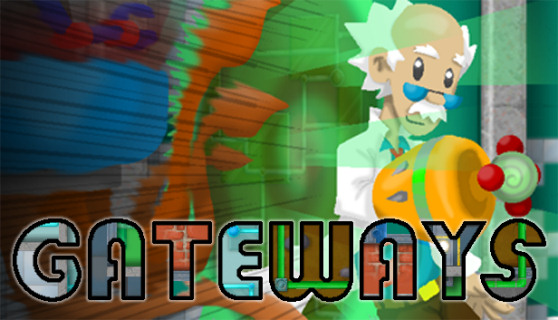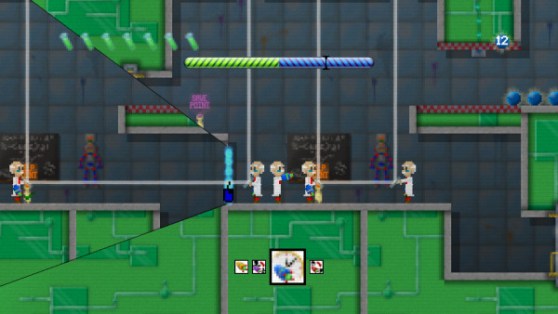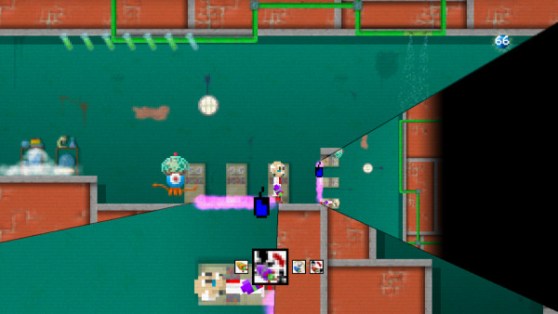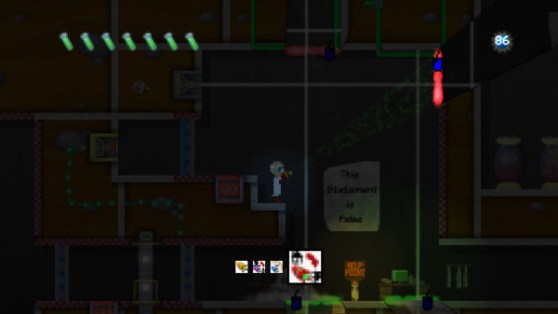Puzzle games are self-descriptive: The best ones combine tiny pieces to create something bigger and more exciting.
That’s exactly what Gateways — a puzzle-platformer from Smudged Cat Games coming out tomorrow, Sept. 13, on PC and Xbox 360 — does with finesse. It’s a little bit Portal, a little bit VVVVVV, a little bit P. B. Winterbottom, a little bit Metroid, and more…but altogether, it’s something much greater. That very idea can mean the difference between a stale game and an innovative one.
“Developers always look at games and think, ‘I like that, but I would have done X, Y, and Z slightly differently,'” Gateways’ creator, David Johnston, told GamesBeat in an interview. “There’s always a lot of talk about people stealing ideas, like declaring every voxel game to be a Minecraft clone. People also accuse Minecraft of stealing ideas from Infiniminer, as well, but really it’s just a new genre of game that has emerged recently. It’s like how every first-person shooter used to be declared a Doom clone, but we now accept that it’s a genre of game.”
At its core, Gateways seems a lot like Valve’s popular series Portal — only applied in 2D instead of a 3D world. As an inventor exploring his own ruined lab, you find the gateway gun, which allows you to reach otherwise inaccessible areas by traveling through two-sided portals. But that’s only the beginning. As you obtain upgrades, you can illuminate dark areas with a “torch” (it’s more like a flashlight), reflect laser beams with a mirror, shrink the professor or make him giant-sized, rotate the gravitational pull, and even create duplicates of yourself by manipulating time. These are all elements we’ve seen in other games.
But the game isn’t all puzzles and solutions. Players must figure out how to defeat the strange alien-like “monkoid” enemies that have infiltrated the inventor’s lab, too, and this requires platforming skills and a fresh perspective.
“The enemies aren’t really there to pose a major threat,” says Johnston. “Once they’re destroyed, they’re gone forever. They’re really just a way to break up the puzzle-solving elements a bit and give you something more action-based to do while you travel between different puzzles. The only exception is the recharging enemy type, which requires a bit more thought to eliminate. I think it’s nice to have a bit of variety. Even if you really love a particular type of game, it can get monotonous if you’re doing the same thing over and over again.”
Gateways keeps its gameplay interesting by challenging players to use techniques in new ways. Time travel is the most difficult by far, especially in combination with the other power-ups, and eventually players can activate all the various gateway guns at the same time. It would be a huge headache if it weren’t so well done and addictive.
The game’s hint system helps with that, too, and it’s something lots of other puzzle games could learn from. For the cost of five power orbs, you can learn whether or not you have progressed enough to solve a puzzle or if you must complete another task first. For 40 orbs, you can pay to see the solution; the game even performs it for you. But the different names of these help points can provide clues as to what players need to do, as well.
Johnston says it’s important to have a good system in place for when players get stuck. “People play games for fun,” he says. “It’s nice to be challenged and feel that sense of accomplishment when you complete a difficult puzzle, but if you get really stuck and can’t continue the game, then you can feel a bit cheated. You’ve paid for all this content but have suddenly been locked out. It’s always a difficult line to tread because if you provide a free help system, it encourages people just to automatically use it, so they never get that sense of accomplishment. At the same time, I don’t like the thought of people running out of orbs and being unable to continue. Hopefully, Gateways gets the balance right!”
But aside from the platforming, puzzles, and hints, another important aspect of the game is the layout, which Johnston says is inspired by Metroid. Here the lab is color-coded, and each section features a different type of music. You can also unlock shortcuts that transport them from the center area to different spots around the map, which is easily viewed at any time. Taking a quick look at it prevents players for getting lost and reveals the next possible objectives.
“I decided quite early on to have different areas of the map,” says Johnston. “It helps break things up a bit and feels like you’re really exploring; it also help a lot with navigation. If everywhere in the map looks exactly the same, then it can be difficult to remember what was at a particular point, but different areas give you a reference. Once I had the different areas, it made sense to have music tracks for each of them to help give them all a different feel. The basement area is very dark and gloomy, the upper section is more high tech with the most difficult puzzles, and the middle area is more platforming-focused.”
While none of the ideas presented in Gateways are revolutionary by themselves, together they become something original and fun. Arguably, Gateways is so enjoyable precisely because Johnston pays attention to what else is out there — he doesn’t create games in a vacuum.
“I do play quite a lot of games,” he says. “It’s really interesting to see what other people are doing, particularly in the indie scene. There are a lot cool ideas out there, and the chances are if you come up with an idea, then someone will have done something similar before. I thought the way you look through gateways was unique, but then I heard about ASCII Portal by Cymons Games. A lot of indie games have really interesting ideas but never quite get the audience they deserve, so it’s always interesting to look and see what’s going on.”
Johnston adds that playing games has made him a better developer. “It helps me to see what other ideas people have tried and what works as a game mechanic,” he says. “Sometimes something sounds like a good idea on paper, but when it’s actually implemented and you get a chance to try it out fully, it doesn’t quite gel somehow. If someone else has already tried an idea that is similar to yours, then it helps to see how it works and if it’s actually something that can be fun.
“One thing I find about puzzle games is that they tend to be pretty linear in general. It’s one of the reasons I decided to set Gateways in an open world and allow the player to explore and discover things off the beaten track. It comes back to that thing of reaching a puzzle in a game and being unable to progress. In those situations, it’s nice to know there are other options to keep you occupied while you [think] about that puzzle that’s proving a bit too tricky.”
Gateways releases tomorrow on Steam, the indie digital download service Desura, and Xbox Live Indie Games as part of the Indie Games Uprising promotion. It costs $5 for PC (initially on sale for $4) and 240 Microsoft Points for XBLIG. Gateways was a winner of this year’s Dream.Build.Play competition from Microsoft.
VentureBeat's mission is to be a digital town square for technical decision-makers to gain knowledge about transformative enterprise technology and transact. Learn More





